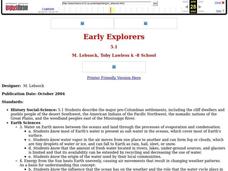Curated OER
Weathering Rocks
Here is a geology lesson that is sure to get your charges excited. It's all about the process of weathering of rocks. Learners study natural events that can cause rocks to break apart. Some of these events are: ice wedging, plant...
Curated OER
Effects of Weathering
Here's a great geology lesson for 3rd graders on weathering and erosion of soil. After a class discussion on how nature can "move a mountain," learners take a look at how a modern phenoma called acid rain can also cause weathering and...
Curated OER
Weathering and Erosion
Students examine the similarities and differences between weathering and erosion. They participate in a lab in which they test the effects of different materials when exposed to weathering and erosion. They record their observations.
National Park Service
Glaciers and Water
Explore the amazing power of glaciers with a hands-on earth science experiment! After first learning basic background information, learners go on to create their very own chunks of frozen water and gravel in order to observe first-hand...
Curated OER
Weathering Rocks
Fourth graders investigate what natural events cause rocks to break apart and differentiate between erosion and weathering. They conduct an experiment with plaster of paris to observe why some rocks are hard and others break, and...
Science 4 Inquiry
Let's Get Moving
Rivers top the list of causes of erosion over time. Scholars experiment with wind, water, and ice reshaping sand. They connect the simulations facts about erosion and deposition to understand unique landforms such as the Grand Canyon and...
Curated OER
Science:Effects of Weathering
Seventh graders take an outdoor observation walk around the campus and take soil samples. Working in groups , they conduct experiments with rocks and soil that demonstrate the effects of different types of erosion.
Science Friday
How Boulders Are Born
Want your class to rock? Then try this boulder activity. Pupils learn about a specific boulder field and use edible materials to demonstrate the geological processes that formed this unique feature. Weathering, erosion, and mass wasting...
Curated OER
Weathering and Erosion
Students investigate how changes occur on the surface of the earth through erosion and glaciation. They observe what happens to salt and iron after they interact with water and vinegar, and analyze what occurs when water is sprinkled on...
Curated OER
Erosion: Slip Sliding Away
Fourth graders investigate the causes of erosion. Through several demonstrations including one using sugar cubes and warm water, they observe the effects of erosion. In groups, 4th graders conduct similar experiments and record their...
Curated OER
A Model of the Rock Cycle
In this rock cycle worksheet, students use different colored crayons to represent different types of rocks. They follow step by step procedures to model the rock cycle with the crayons. Students draw the rock cycle, show weathering,...
Curated OER
Freezing Cracks
Fourth graders examine how weather events cause weathering of the Earth's surface and how freezing water creates cracks and broken rocks over time. They observe what happens when a jar full of water is frozen overnight, and record their...
Curated OER
Soil Types
Fifth graders examine how sand and rock fragments in soil are products of erosion or the weathering of rocks. They listen to the book "Sand" by Ellen J. Prager and answer discussion questions. Next, they analyze sand samples and sort...
Curated OER
You're as Cold as Ice!
Students study the movement of glaciers and how they have affected the Earth. In this geology lesson students simulate the effects glaciers have on landscape and watch video segments.
Curated OER
The Earth Around Us: Air, Water & Soil
Second graders explore erosion and find the factors effecting erosion of hillsides. In this erosion lesson, 2nd graders experiment by creating a hillside and simulating rain. Students discuss and record their results on a worksheet.
Curated OER
Erosion Lab
Eighth graders explore variables that influence the rate of erosion due to the 4 major agents. They work as a group and practice conducting experiments according to the scientific method. Students comprehend that communicating ideas...
Curated OER
Landforms in a Tub
Fifth graders use common household items to build landforms and simulate weathering and erosion.
Curated OER
Geological Features: How Weathering & Erosion Help Create Landforms
Young scholars explore how the Earth's surface changes resulting in geological features and landforms. They perform a read-a-loud on Thomas
Locker's Mountain Dance, complete a KWL chart, and create a
landform using plaster of paris.
Curated OER
Early Explorers
Fifth graders study early explorers. In this World history lesson, 5th graders draw an outline of a map labeling each part, build geographical features out of dough, and paint each of the land and water features.
Curated OER
TRB 5:2 - Activity 3: Earthquakes
Young scholars watch a classroom demonstration, and experiment to discover the five ways that Earth's crust shifts along a fault.
Curated OER
FOLLOW THAT WATER
Students build simple stream tables and vary the angle of the stream tables in order to simulate different flow rates and compare the results. They observe various features formed in a stream table by flowing water and compare these to...






















